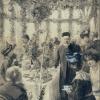2: Drawing, Solomon Joseph Solomon's “High Tea in the Sukkah,” 1906.
Solomon Joseph Solomon’s drawing of Dr. Hermann Adler, the Chief Rabbi of Great Britain, in his sukkah, illustrates turn-of-the-century Jews’ adaptation of Jewish and British customs. Jews with uncovered heads and ladies wearing elegant hats celebrate together with the Chief Rabbi, bringing the British custom of high tea into the Jewish custom of eating in the sukkah.
Suggested Activity: Have your students discuss the following questions: To what extent is it important that this event is occurring in a sukkah, as opposed to some other space? How would you experience the drawing differently if it were "High Tea at a Jewish Social Club" instead? Why? Can you think of contemporary instances where traditional religious practices and secular rituals are merged either seamlessly or with some tension?
Have your students compare this painting to Oppenheim’s painting in resource #1 above. Are there similar concerns of class on display? Do the participants seem to be celebrating the holiday in similar ways? What message do you think each artist aims to relate about the identity and practice of the Jewish community he depicts, and about the meaning of the holiday?
Source: Solomon Joseph Solomon, "High Tea in the Sukkah," 1906. Ink, graphite, and gouache on paper. 16 1/8 × 12 in. The Jewish Museum, Gift of Edward J. Sovatkin.

